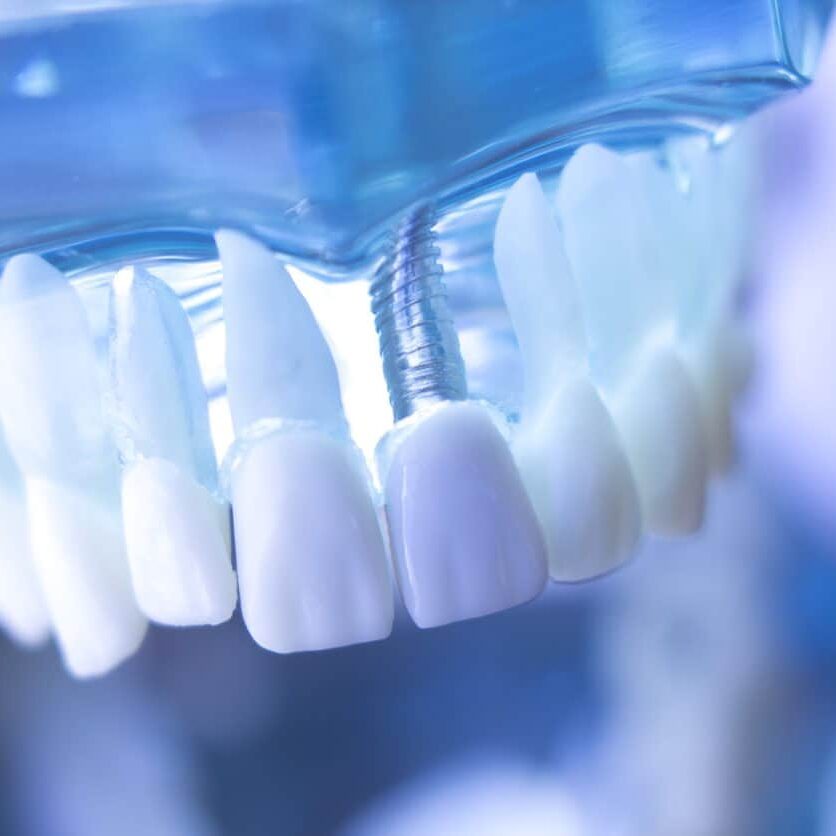Love Your Smile
Dental Implants IL
At Allstar Implants Plus in Illinois, we pride ourselves on offering top-tier dental implant services to our patients. Dental implants are a revolutionary solution for replacing missing teeth, providing a permanent and natural-looking restoration that enhances both aesthetics and functionality. Our team of skilled professionals at Allstar Implants Plus is dedicated to delivering exceptional care throughout every step of the dental implant process, from initial consultation to final restoration.
We understand that each patient's dental needs are unique, which is why we tailor our treatment plans to suit individual preferences and requirements. Whether you are missing a single tooth or multiple teeth, our experienced dentists will work closely with you to develop a personalized treatment plan that meets your specific goals. With state-of-the-art technology and advanced techniques, we ensure that our patients receive the highest standard of care and achieve optimal outcomes with their dental implants.
At Allstar Implants Plus in IL, we believe that everyone deserves a healthy and beautiful smile. With our expertise in dental implants and commitment to patient satisfaction, we strive to restore confidence and improve quality of life for each of our patients. If you're considering dental implants as a solution for tooth loss, schedule a consultation with Allstar Implants Plus today to learn more about how we can help you achieve a smile that looks and feels natural.

Transform Your Smile in Just One Day: Same-Day Dental Implants at Allstar Implants Plus in Illinois
Experience the convenience and confidence of same-day dental implants at Allstar Implants Plus. With our advanced technology and expertise, you can walk into our office with missing teeth and leave with a brand-new smile in just one day. Our streamlined process allows for the placement of dental implants and the attachment of prosthetic teeth on the same day, eliminating the need for multiple appointments and lengthy waiting periods.
Using state-of-the-art techniques like guided implant placement and immediate loading, our skilled team can efficiently and effectively restore your smile in a single visit. Whether you're missing one tooth or an entire arch, our same-day dental implant procedure offers a fast and reliable solution for tooth replacement. Say goodbye to gaps in your smile and hello to a confident new you with same-day dental implants from Allstar Implants Plus.
1 Stop - Dental Implants Expertise
At Allstar Implants Plus, you don't have to see multiple doctors or travel to different offices. Our implant experts care for your entire treatment in the comfort of our office from start to finish.
Meet Dr. Sam Simos: Teaching Other Dentists
Dr. Sam Simos is highly experienced and knowledgeable in both dental implant surgery and cosmetic dentistry.
Unlike most dentists, Dr. Simos is a widely published author on the use of dental implants, cosmetic dentistry, restorative dentistry, and digital and 3D printing in dentistry.
While a clinical instructor at the Las Vegas Institute for Advanced Dental Studies, Dr. Simos taught thousands of dentists on topics including cosmetic smile design, occlusion, full arch and full mouth restoration.
This high level of expertise allows Dr. Simos to design, surgically place and accurately position your dental implants to achieve optimal function and cosmetic results for your new teeth.
Comprehensive FAQs on Dental Implants: Your Guide to Understanding Implant Dentistry
What are dental implants, and how do they function within the oral cavity?
Dental implants are titanium posts surgically inserted into the jawbone to replace missing tooth roots. They serve as stable foundations for various dental restorations, like crowns, bridges, or dentures, ensuring a secure and natural-looking smile.
Who is an ideal candidate for dental implant placement?
Suitable candidates for dental implants generally possess good oral health and sufficient jawbone density to support the implants. However, individuals with specific dental issues, such as gum disease or bone loss, may still qualify for implants with appropriate treatment and preparation.
What does the dental implant procedure entail, and what are its stages?
The dental implant process typically involves several stages, including an initial consultation, implant placement surgery, osseointegration (the fusion of implants with the jawbone), and finally, the attachment of dental restorations. Treatment duration varies based on individual circumstances and case complexity.
Are dental implants considered permanent solutions for tooth replacement?
Dental implants are intended as long-term solutions for tooth replacement, offering durability and longevity with proper care. Regular oral hygiene practices and routine dental check-ups are essential to ensure the longevity of dental implants, which can potentially last a lifetime.
What advantages do dental implants offer over traditional tooth replacement options?
Dental implants offer numerous benefits, including enhanced aesthetics, improved chewing function, preservation of jawbone structure, and heightened comfort and confidence. Unlike removable dentures, dental implants are securely anchored in the jawbone, mimicking the stability and functionality of natural teeth.
Is discomfort associated with the dental implant procedure?
While some discomfort may occur during dental implant surgery, local anesthesia and sedation options are available to ensure patient comfort. Post-operative discomfort can typically be managed with over-the-counter pain medication.
What is the success rate of dental implants, and what factors contribute to it?
Dental implants boast a high success rate, with studies indicating success rates of over 95% in properly selected patients. Factors such as good oral hygiene, overall health, and precise implant placement significantly influence the success and durability of dental implants.
How long is the recovery period following dental implant surgery?
Recovery time varies among patients but generally ranges from several days to a few weeks. Most patients can resume normal activities shortly after surgery, with minor restrictions on strenuous activities and dietary adjustments during the initial healing period.
Does dental insurance typically cover the cost of dental implants?
Coverage for dental implants varies depending on individual insurance plans and policies. Some insurance providers may offer partial coverage for dental implants cost, such as surgical procedures or dental restorations. It is advisable to consult with your insurance provider to understand your specific coverage options.
Elevate Your Smile Experience: Why Dr. Simos at Allstar Implants Plus Is Your Premier Choice in IL
When it comes to enhancing your smile and restoring dental health, Dr. Sam Simos stands as a beacon of excellence in the field of dentistry. With over three decades of experience and a reputation for delivering exceptional results, Dr. Simos brings a wealth of knowledge and expertise to every patient interaction. As a nationally recognized figure in the dental community, his commitment to advancing the field of dentistry is unparalleled, ensuring that patients receive the highest standard of care. Dr. Simos, our esteemed dental implant dentist, leads the way in providing exceptional care and expertise in dental implant procedures.
At Allstar Implants Plus IL, Dr. Simos and his dedicated team prioritize patient satisfaction and well-being above all else. From the moment you step into our state-of-the-art facility, you'll be greeted with warmth and professionalism, setting the stage for a comfortable and stress-free experience. With Dr. Simos's extensive education and track record of success, you can trust that you're in capable hands, whether you're seeking dental implants, cosmetic enhancements, or general dental care. Choose Dr. Simos at Allstar Implants Plus for a smile transformation that exceeds your expectations.
Transformative Dental Implants: Embrace Health, Aesthetics, and Happiness with a Radiant Smile
Enhanced Oral Health:
Dental implants are not just about restoring missing teeth; they also promote overall oral health. Unlike traditional bridges or dentures, which may require altering adjacent teeth, implants preserve the natural tooth structure. This preserves the integrity of surrounding teeth and helps prevent bone loss, maintaining the health of your jawbone and facial structure.
Improved Aesthetics:
Dental implants provide a natural-looking solution for tooth replacement, seamlessly blending in with your existing teeth. With customizable options for size, shape, and color, implants are tailored to match your unique smile, ensuring a harmonious and aesthetically pleasing result. Say goodbye to gaps and hello to a confident, radiant smile that you'll be proud to show off.
Restored Functionality:
Missing teeth can make everyday tasks like chewing and speaking challenging. Dental implants restore full chewing function and speech clarity, allowing you to enjoy your favorite foods without discomfort or limitations. With implants, you can regain the ability to eat, speak, and smile with confidence, enhancing your overall quality of life.
Boosted Self-Confidence:
Your smile is a reflection of your personality and self-esteem. Dental implants not only improve the appearance of your smile but also boost your confidence and self-image. By restoring your smile to its full potential, implants empower you to socialize, laugh, and express yourself without hesitation, leading to greater happiness and overall well-being.
Long-Term Durability:
Unlike traditional tooth replacement options that may require frequent repairs or replacements, dental implants offer long-term durability and stability. With proper care and maintenance, implants can last a lifetime, providing you with peace of mind and saving you from the hassle and expense of frequent dental interventions.
Preventative Benefits:
Dental implants also offer preventative benefits by stabilizing adjacent teeth and preventing them from shifting out of alignment. This helps maintain proper bite alignment and reduces the risk of oral health issues such as TMJ disorders and gum disease, further safeguarding your overall dental health.
Natural Look and Feel:
Dental implants closely mimic the look and feel of natural teeth, providing a comfortable and seamless solution for tooth replacement. Unlike removable dentures, implants are securely anchored in the jawbone, eliminating concerns about slippage or discomfort and allowing you to enjoy a natural and unrestricted smile.
Enhanced Facial Structure:
Tooth loss can lead to changes in facial appearance, such as sagging cheeks and wrinkles around the mouth. Dental implants help preserve the natural contours of your face by stimulating the jawbone and preventing bone loss. This results in a more youthful and rejuvenated appearance, enhancing your overall facial aesthetics.
Improved Speech:
Missing teeth can affect speech clarity and pronunciation, leading to difficulties in communication. Dental implants restore proper tooth alignment and function, improving speech articulation and allowing for clearer and more confident communication.
Life-Changing Results:
The impact of dental implants extends far beyond just restoring missing teeth; it transforms lives. With dental implants, you can enjoy improved oral health, enhanced aesthetics, and renewed confidence, enabling you to embrace life to the fullest and love your smile again. Say goodbye to dental insecurities and hello to a brighter, happier future with transformative dental implants.
Revolutionize Your Smile with All-on-4 and All-on-X Dental Implants
Experience the transformative power of All-on-4 and All-on-X dental implants, innovative solutions that offer comprehensive tooth replacement with unparalleled stability and functionality. With All-on-4, four titanium implant posts are strategically placed in the jawbone to support a full arch of prosthetic teeth. This revolutionary technique eliminates the need for individual implants for each missing tooth, reducing treatment time and cost while providing a secure and natural-looking smile. The All-on-4 system utilizes angled implants to maximize bone support and minimize the need for bone grafting, making it an ideal option for patients with compromised jawbone density.
Similarly, All-on-X dental implants offer a seamless and reliable solution for full arch tooth replacement. By utilizing a combination of dental implants and a custom-designed prosthetic bridge, All-on-X restores an entire arch of teeth with exceptional stability and aesthetics. The innovative All-on-X system provides flexibility in implant placement, allowing for optimal bone utilization and minimizing the need for additional surgical procedures. With both All-on-4 and All-on-X, patients can enjoy the benefits of a complete smile restoration in a single procedure, transforming their oral health and confidence with minimal downtime. Say goodbye to removable dentures and hello to a permanent solution that looks, feels, and functions like natural teeth.
Dental Implants: Advancements in Procedure and Materials
Embark on a journey towards a radiant smile with the cutting-edge procedure of dental implants. At Allstar Implants Plus, we pride ourselves on staying at the forefront of dental technology and techniques, ensuring that our patients receive the most advanced and effective treatments available. The process begins with a comprehensive consultation, during which our experienced team evaluates your oral health and discusses your treatment goals. Using state-of-the-art imaging technology, such as digital X-rays and 3D scans, we create a precise treatment plan tailored to your unique needs.
Once your treatment plan is finalized, the dental implant procedure begins with the surgical placement of titanium implant posts into the jawbone. This serves as the foundation for your new teeth, providing unparalleled stability and durability. Thanks to advancements in oral surgery techniques and materials, such as guided implant placement and minimally invasive procedures, the implant placement process is now more efficient and comfortable than ever before. Our skilled team ensures that each implant is precisely positioned for optimal function and aesthetics, laying the groundwork for a beautiful and long-lasting smile.
In addition to advancements in the implant procedure itself, Allstar Implants Plus is committed to contributing to innovations in dental materials and technologies. Our dedication to research and development has led to the integration of state-of-the-art techniques like digital impressions and 3D printing into our practice. These technologies allow for the fabrication of custom-made dental restorations with unmatched precision and accuracy, ensuring seamless integration with your natural teeth. By harnessing the power of digital and 3D printing technologies, we can provide our patients with results that exceed their expectations and elevate the standard of care in dental implantology.
World class smile expertise
Feel comfortable and at ease
Affordable cost & no surprises
Smile Care from A to Z
Ready to schedule your free consult? Contact us today!





